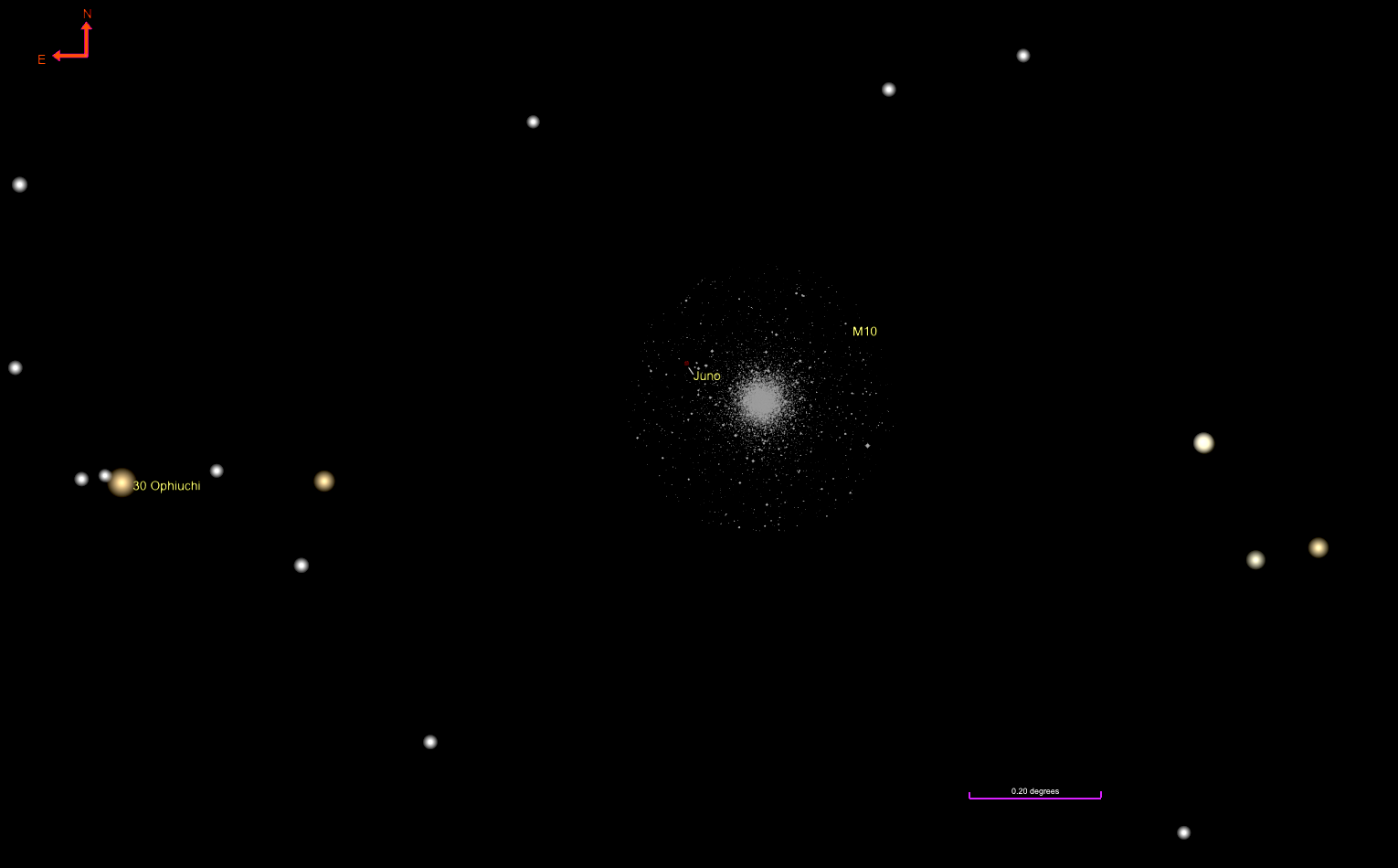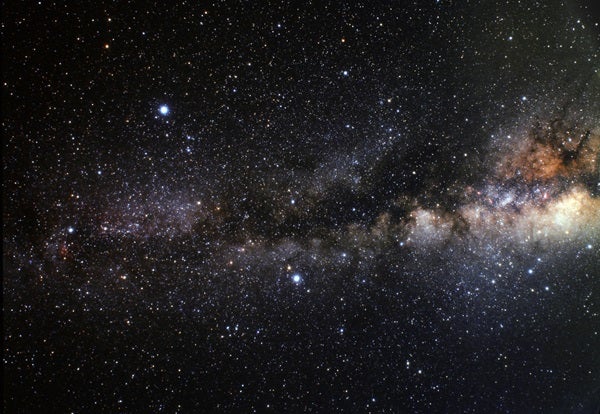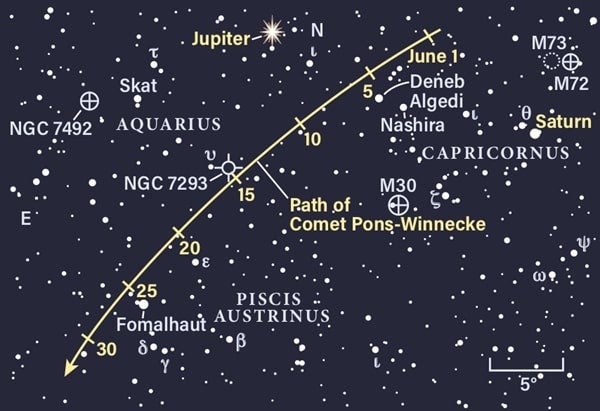

The Summer Triangle asterism returns to the night sky as the summer season approaches in the Northern Hemisphere.
Giuseppe Donatiello (Flickr)
Friday, June 11
An asterism is an unofficial pattern of stars that isn’t one of the 88 officially recognized constellations that cover the sky. The Summer Triangle is a well-known asterism in the Northern Hemisphere sky. Its name comes from the fact that it’s visible all night during summertime in this hemisphere; now, it’s finally visible after sunset, rising in the east as the sky grows dark.
The Summer Triangle comprises three bright blue stars: magnitude 1.3 Deneb in Cygnus, magnitude 0.8 Altair in Aquila, and magnitude 0 Vega in Lyra. Starting at Vega, Altair sits 35° to the southeast. From Altair, look 38° north to Deneb, which also sits east of Vega.
The Summer Triangle will continue to rise after dark, passing its highest point overhead around 3:30 A.M. local time and setting well after sunrise.
Sunrise: 5:31 A.M.
Sunset: 8:29 P.M.
Moonrise: 6:15 A.M.
Moonset: 9:55 P.M.
Moon Phase: Waxing crescent (1%)
*Times for sunrise, sunset, moonrise, and moonset are given in local time from 40° N 90° W. The Moon’s illumination is given at 12 P.M. local time from the same location.

Comet 7P/Pons-Winnecke passes closest to Earth on June 12. Three days later, on the 15th, it skims less than 1° from the Helix Nebula. The positions of Jupiter and Saturn are shown on the 15th.
Astronomy: Roen Kelly
Saturday, June 12
Today marks the closest approach of Comet 7P/Pons-Winnecke to Earth, when it will come within 0.44 astronomical unit (1 astronomical unit, or AU, is the average Earth-Sun distance) of our planet. It’s currently magnitude 11 and is an early-morning object, rising around 1 A.M. local time in Aquarius, which also hosts the bright planet Jupiter. Saturn is nearby in Capricornus. A 6-inch scope under a dark sky will easily net you this fuzzball, which you can find 7.5° south of Jupiter or 7.6° east-southeast of Deneb Algedi.
You’ll want to return to this region on the 15th, when Pons-Winnecke passes close to the Helix Nebula (NGC 7293). The nebula is currently 3.6° east-southeast of the comet’s position; Pons-Winnecke will draw closer and pass less than 1° south of the Helix before sunrise on Tuesday.
The Moon passes 1.5° north of Venus at 3 A.M. EDT. By sunset, they’re roughly 8° apart with the Moon farther east, hanging 4.5° below Pollux in Gemini. Venus sits 11.6° below Castor, which glows 4.5° to Pollux’s right as the Twins sink feet first below the horizon.
Venus also reaches perihelion today — the closest point to the Sun in its orbit around our star.
Sunrise: 5:31 A.M.
Sunset: 8:29 P.M.
Moonrise: 7:06 A.M.
Moonset: 10:44 P.M.
Moon Phase: Waxing crescent (5%)
Sunday, June 13
The Moon passes 3° north of Mars at 4 P.M. EDT. Look west shortly after sunset to spot the pair in Cancer, with Mars a little less than 3° to the thin crescent Moon’s southwest half an hour after the Sun disappears. Mars glows at magnitude 1.8, popping out among some of the brighter stars as the sky begins to darken. Much brighter Venus — magnitude –3.9 — stands 17.5° west of the Red Planet. Venus is located in Gemini, forming the point of a deep V between Pollux (left) and Castor (right).
Because it starts out lower in the sky, Venus sets earlier (around 10 P.M. local time, depending on your location). It currently spans about 11″ and appears 93 percent lit. Mars, by contrast, is 96 percent lit and a mere 4″ across. It sets an hour later, giving you more time to study it as well as Cancer’s famous Beehive Cluster, currently about 6° east of Mars. The Red Planet will slide right through this open cluster of stars later this month.
Sunrise: 5:31 A.M.
Sunset: 8:30 P.M.
Moonrise: 8:03 A.M.
Moonset: 11:27 P.M.
Moon Phase: Waxing crescent (10%)
Monday, June 14
About an hour after sunset tonight, the Big Dipper is standing on the edge of its cup, handle pointing high in the air. Swing binoculars or a small telescope about 3.6° southwest of Alkaid, the last star at the tip of the handle, and you’ll land on the beautiful spiral galaxy M51, also known as the Whirlpool Galaxy or NGC 5194. It’s located in Canes Venatici the Hunting Dogs, one of Ursa Major’s many neighboring constellations.
Discovered October 13, 1773, by Charles Messier, this magnitude 8.4 spiral appears face on from our vantage point. This galaxy also brought a dance partner to the party: a smaller galaxy, which glows at magnitude 9.6, cataloged as NGC 5195 and sometimes also called M51B. These two galaxies have recently undergone a close encounter a mere few million years ago, and still present a stunning pair to behold. They are best viewed on nights with a dark sky and at times when they are near the zenith, or top of the sky. Under good conditions, observers with larger apertures can often make out hints of M51’s spiral arms.
Sunrise: 5:31 A.M.
Sunset: 8:30 P.M.
Moonrise: 9:05 A.M.
Moonset: —
Moon Phase: Waxing crescent (17%)
Tuesday, June 15
Leo the Lion is headed, nose down, toward the horizon at sunset. The Moon, now a beautiful 29-percent-lit crescent, hangs near magnitude 3.5 Eta (η) Leonis, with bright Regulus just over 4° to our satellite’s south.
But north of Leo is another, smaller constellation you might not be as familiar with: Leo Minor the Lion Cub. To find this dim constellation, it’s easiest to draw a line between Merak (the star at the lower right-hand corner of the Big Dipper’s cup) and Regulus in Leo. Exactly halfway along that line is Leo Minor, the sky’s 64th-largest constellation. Its brightest star is magnitude 3.8 46 Leonis Minoris, which outshines Leo Minor’s magnitude 4.2 beta star. (There is no alpha star in this constellation!)
Leo Minor is home to several deep-sky objects, including the magnitude 11.7 edge-on galaxy NGC 3432 and the face-on spiral NGC 3344, which shines a brighter magnitude 9.9. The former you’ll need a larger telescope (8 inches or more) to see, while the latter can be spotted with large binoculars or a small telescope. The moonlight may make such targets a bit challenging tonight, so come back on a night when the Moon is farther away if you’re having trouble finding them or teasing out fine detail.
Sunrise: 5:31 A.M.
Sunset: 8:31 P.M.
Moonrise: 10:10 A.M.
Moonset: 12:04 A.M.
Moon Phase: Waxing crescent (25%)
Wednesday, June 16
Boötes the Herdsman is high in the south after sunset, anchored by the bright star Arcturus. But the kite-shaped constellation boasts numerous other stars worth a look, including three double stars: Kappa (κ), Iota (ι), and Pi (π) Boötis. Each is visible to the naked eye, with Kappa the brightest (magnitude 4.5) and the other two tied at roughly magnitude 4.9. Each will also appear to the naked eye as a single star, but a small telescope will change up the view.
Kappa Boötis is located about 1.8° west of Theta (θ) Boötis, which shines at magnitude 4. It lies between Theta and Alkaid, the star at the tip of the Big Dipper’s handle. With a telescope, Kappa resolves into a pair of stars just over 13″ apart. One will appear bluer than the other, which appears pearly white.
Iota Boötis lies nearby. It’s about 35′ southeast of Kappa, or 1.5° southwest of Theta. This double is much farther apart — 38″ — with one component glowing yellow-white and the other a purer white.
Pi Boötis lies in the southeastern portion of the constellation, 2.7° due north of Zeta (ζ) Boötis and 6.5° southeast of Arcturus. Pi is a close double separated by less than 6″ but is still easy to split through a 3-inch scope to reveal its contrasting blue-white and yellow-white stars.
Sunrise: 5:31 A.M.
Sunset: 8:31 P.M.
Moonrise: 11:17 A.M.
Moonset: 12:37 A.M.
Moon Phase:
Moon Phase: Waxing crescent (35%)
Thursday, June 17
Asteroid 3 Juno lies in the northeastern outskirts of globular cluster M10 tonight. Located in Ophiuchus, you’ll find the pair high in the southeast after dark. Juno glows a dim magnitude 10, compared with M10’s total magnitude of 6.6. You’ll need binoculars or a telescope to enjoy the view.
M10 spans roughly 20′; at its distance of 14,300 light-years, that translates to a diameter of 83 light-years across. In most amateur instruments, however, the cluster will appear to subtend only about 9′ — the region covered by its brightest stars. Juno, by comparison, sits just over 2 AU from Earth, or twice the average Earth-Sun distance. Its light takes a mere 20 minutes to reach us.
First Quarter Moon occurs late tonight at 11:54 P.M. EDT.
Sunrise: 5:31 A.M.
Sunset: 8:31 P.M.
Moonrise: 12:24 P.M.
Moonset: 1:06 A.M.
Moon Phase: Waxing crescent (45%)
Friday, June 18
The waxing Moon lies nestled in the heart of the constellation Virgo this evening. Shortly after sunset, as the brightest stars begin to pop out, you’ll notice our satellite sits close — within 1.2° — of magnitude 2.7 Porrima. To their southeast is brighter magnitude 1 Spica, Virgo’s alpha star.
Porrima is named for the Roman goddess of prophecy. Like the name Spica, it derives from Latin, unlike the Arabic names most stars carry. Home in on Porrima with a telescope and you’ll see it is not one, but two stars: Both are nearly identical F stars that blaze hotter than the Sun. Lying nearly 40 light-years away, these stars orbit each other once every 169 years. That means a human observer who revisits this star throughout their lifetime will notice their motion over time. Their orbits are highly elliptical (egg-shaped) and their last closest approach was in 2005. They are now slowly growing farther apart.
Sunrise: 5:31 A.M.
Sunset: 8:32 P.M.
Moonrise: 1:33 P.M.
Moonset: 1:33 A.M.
Moon Phase: Waxing gibbous (56%)









